|
Linda Kaye 1942-2007 | Linda the saver | Gone, not forgotten | Recollections | Gallery
The inimitable Linda Kaye
1942-2007
Chancellors have come and gone. Buildings have been constructed and remodeled. The Frogs have won and lost. Through it all, photographer Linda Kaye '63 was there, on the sidelines, in the classroom and wandering the campus, camera at the ready. She literally saw TCU grow up through her viewfinder — and thanks to her, so can we.

By Rick Waters '95
Her first pictures were taken at Amon Carter Stadium. So were her last.
For five decades, Linda Kaye '63 loved all things TCU, especially its athletics heroes.
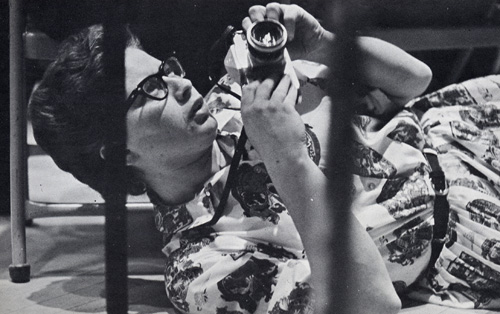 When she first looked through the lens, Linda was a student at Paschal High School, and her all-time favorite Horned Frog, all-American halfback Jim Swink '57, was zigging, zagging and amazing crowds in Fort Worth and across the country. When she first looked through the lens, Linda was a student at Paschal High School, and her all-time favorite Horned Frog, all-American halfback Jim Swink '57, was zigging, zagging and amazing crowds in Fort Worth and across the country.
Linda was among them — on the sidelines, camera at the ready.
By the time Linda enrolled as a Frog freshman in 1959, the Rusk Rambler was gone, but she had found her calling. She would shoot for TCU Athletics for as long as she could.
For the TCU Daily Skiff.
For the Horned Frog yearbook.
Her client list expanded to include every department at TCU, as well as the Associated Press, local sports teams and a host of friends, for whom she happily documented the important events of their lives.
On Oct. 7, Linda lost a long battle with cancer, a disease that thinned her out, took her hair and finally, stole her from us. She was 65.
* * *
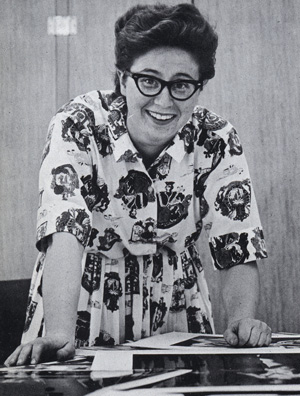 For nearly five decades, Linda was the "official" unofficial photographer for TCU. Convocations. Graduations. Bowl games. Anything any TCU department wanted captured on film, Linda was the go-to person. For nearly five decades, Linda was the "official" unofficial photographer for TCU. Convocations. Graduations. Bowl games. Anything any TCU department wanted captured on film, Linda was the go-to person.
Candids. Mug shots. Portrait photography. Everything was in her repertoire. Clients would often tell her to "just show up and shoot something." So she did, ever reliable. Always finding that one special shot.
Her official TCU career began as a staff photographer for the Skiff and Horned Frog as a freshman. By the time she was a junior, Linda was sports editor of the newspaper and editor-in-chief of the yearbook. Her senior year, she passed on being the editor a second time to be both publications "Head Photographer." That was the job she wanted.
Along the way, she was an English and journalism student with exemplary grades. She made the Dean's list multiple times and was a two-time member of the scholarship fraternity Alpha Chi, which required a 3.5 grade-point average of juniors and seniors. She was on the Publications Committee, was the winner of the Creative Writing Day Award and was secretary of the Women's Sports Association, which promoted women's interest in athletics, intramurals, fellowship and health. All things Linda loved.
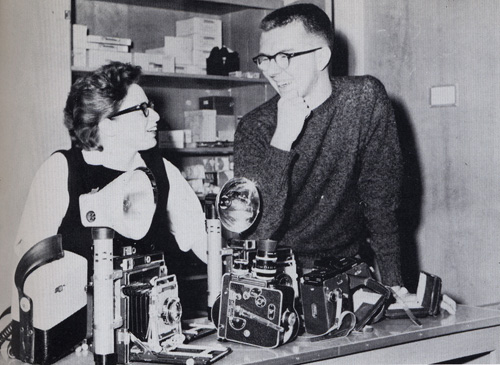 She never joined a sorority, never ran for office in student government and never played on a varsity athletic team, but she photographed them all. A "Frog Beauty" or "TCU Sweetheart" she wasn't, but her classmates loved and respected her so much they listed her among the class favorites. She never joined a sorority, never ran for office in student government and never played on a varsity athletic team, but she photographed them all. A "Frog Beauty" or "TCU Sweetheart" she wasn't, but her classmates loved and respected her so much they listed her among the class favorites.
In the 1963 Horned Frog, her photo resides in the list of Who's Who in American Colleges and Universities.
Through the years, Linda also became associated with purple. Purple shirt. Purple socks. Purple shoes. And as some have aptly said, "Big ol' purple heart."
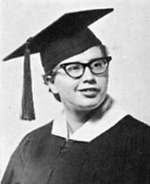 In her final days, laid up in a hospice bed in southwest Fort Worth, she was surrounded by purple flowers, purple pennants, purple mints and purple balloons. In her final hours, she wore a purple TCU shirt and purple socks. In her final days, laid up in a hospice bed in southwest Fort Worth, she was surrounded by purple flowers, purple pennants, purple mints and purple balloons. In her final hours, she wore a purple TCU shirt and purple socks.
Her home, which few have seen, is literally a museum of TCU bric-a-brac, the culmination of years of photographing campus events and scavenging at area yard sales. Belt buckles. Gimme hats. Used soda cups. Bumper stickers. Buttons. Some sport the old "Flying T" logo. Some even older than that.
Few knew she also was an ardent fan of Howard "Hopalong" Cassidy and had, in her brother Roger's estimation, "the biggest and best collection of Hopalong memorabilia in the world."
One room in her home is practically wall-papered in autographed photos that she shot. Ben Hogan. Bob Hope. John Connally. Earl Campbell. Ruta Lee. Van Cliburn. Joe DiMaggio, Phyllis Diller, Pudge Rodriguez, Darryl Royal, a young Bob Schieffer.
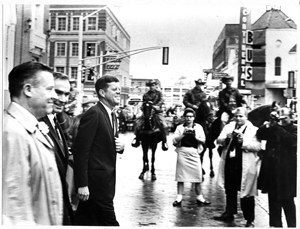 And every president dating to LBJ. There's even one of her shooting pictures of John F. Kennedy outside the Hotel Texas on that fateful day, Nov. 22, 1963; another shows her walking in Burnett Park with Richard Nixon. And dozens more famous faces. And every president dating to LBJ. There's even one of her shooting pictures of John F. Kennedy outside the Hotel Texas on that fateful day, Nov. 22, 1963; another shows her walking in Burnett Park with Richard Nixon. And dozens more famous faces.
These items will be displayed in the Mary Couts Burnett Library, along with a collection of her photography, in a special area that will bear her name. Her thousands and thousands of negatives will be cleaned and stored in university archives.
TCU Athletics honored her with a photo gallery at Amon Carter Stadium the rest of the 2007 season.
Brite Divinity School's Jewish Studies program will showcase her assortment of menorahs.
The Schieffer School of Journalism sent a contingent to her room in her final week to present her with a plaque and to induct her into the school's Hall of Excellence. She's the first photojournalist.
On Oct. 7, the TCU flag rested at half-staff in her memory.
* * *
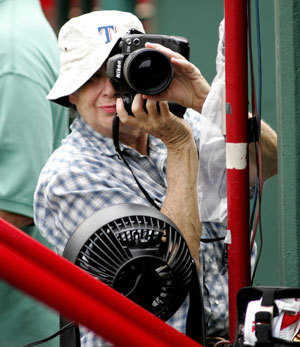 One did not have to have met Linda to know her work. In addition to TCU, Linda shot faithfully for the Texas Rangers, Dallas Cowboys and, for a brief time, the University of Texas. Among her most famous images is one of a bloodied Nolan Ryan, determined to continue pitching for the Rangers after taking a Bo Jackson one-hopper off his lip one night at Arlington Stadium. One did not have to have met Linda to know her work. In addition to TCU, Linda shot faithfully for the Texas Rangers, Dallas Cowboys and, for a brief time, the University of Texas. Among her most famous images is one of a bloodied Nolan Ryan, determined to continue pitching for the Rangers after taking a Bo Jackson one-hopper off his lip one night at Arlington Stadium.
Linda also snapped the now-iconic image at the Cotton Bowl in January 1970 of University of Texas coach Darrell Royal and quarterback James Street with their heads together, scheming out the next play. Behind them the scoreboard reads Notre Dame 17, Texas 14, fourth-and-2, 2:26 left. On the next play, the Longhorns won a national championship.
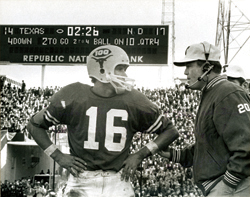 It was reported that Royal would later call it the greatest sports photograph he ever saw. He autographed it, "Great shot, Linda." Street commissioned a painting of the photo that hangs in his home today. It was reported that Royal would later call it the greatest sports photograph he ever saw. He autographed it, "Great shot, Linda." Street commissioned a painting of the photo that hangs in his home today.
Linda was still shooting photos on the sidelines early this season, with brother Roger holding onto her from behind to keep her from falling.
"The pain was incredible, but she wanted to do it," Roger said. "She said, 'I want to do my work. I want to keep taking my pictures.'"
So she did.
That dogged determination through the years gave rise to a knack of being in the right place at the right time, an art she learned from mentors Al Panzera, Gene Gordon and Harry Cabluck.
"He taught me everything," Linda said of Panzera, the legendary Star-Telegram sports photographer of the 1960s and '70s.
However, unlike Panzera, Linda always preferred the independence of being a freelancer. Thousands of her photos graced the local sports pages over the decades.
 Linda says she was lucky. Linda says she was lucky.
"You take pictures for 40 or 50 years, you're bound to get a couple," she told Star-Telegram columnist and friend Jim Reeves before she died. "I got a couple. I wasn't a great photographer. I was more of a technician."
Hogwash.
She was the first to begin snapping images of coaches and players on the sidelines, in the bus and in those moments when the emotion, grit and pain was most apparent.
"She never thought of herself as a pioneer," Roger said. "But she was one of the first women on the field with a camera."
When she wasn't freelancing, she made photography her gift to others. She was the go-to gal for hundreds of local families and celebrities, happily and faithfully recording their important dates and events.
* * *
Always private and fiercely independent, Linda had a heart attack in 1999 and surgery for uterine cancer in 2002. Few knew. Exactly the way she wanted it.
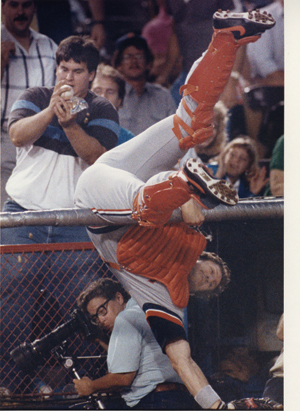 Her cancer returned a year ago, and doctors told her she probably had 12 months. A few months later she stopped chemotherapy treatments. It wasn't helping. Her cancer returned a year ago, and doctors told her she probably had 12 months. A few months later she stopped chemotherapy treatments. It wasn't helping.
"I figured it wasn't worth the trouble," she said from her hospital room a few weeks before she died.
Typical Linda. Straightforward, even to a fault. Her candor and get-outta-my-way attitude was legendary, even with chancellors and visiting dignitaries, often waving them into position for a picture. It may have been someone else's event, but these were her photographs.
She treated athletes the same, communicating in a language in which they could relate.
Frog Club Director John Denton '85 recalled meeting Linda for the first time as a freshman place kicker in August 1980. It was Team Picture Day.
"We really hadn't even had a practice yet, but Linda was at full speed," he remembers. "She looked me square in the eye and said, 'Are you a football player?' I nodded. 'Well then, act like one. Stand up straight!' "
Linda understood athletes and game pressure, living in a split-second world. Photographers either get the shot or they don't. Linda rarely missed.
Inspired by her father, Max, who was her first photography instructor, Linda was fearless, often standing in harm's way for the right angle.
"She was shooting a TCU practice years ago when Tommy Joe Crutcher '65 came sweeping around the end and ran right over Linda. They both went down in a heap," Reeves wrote in an October column. "It was Linda who jumped up first, held out a hand to help Crutcher up with the question: 'You OK, Tommy Joe?' "
* * *
Her directness never diminished the appreciation people had for her.
When she was admitted to the hospital in late September, word spread, and visitors flocked to her side by the dozen.
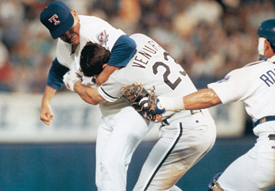 Chancellor Victor Boschini visited daily, even bringing a milkshake once. Chancellor Emeritus William Tucker '56 offered prayers. Former athletics director Frank Windegger '57 stopped to say hello. The Horned Frogs basketball team sent personal messages. Chancellor Victor Boschini visited daily, even bringing a milkshake once. Chancellor Emeritus William Tucker '56 offered prayers. Former athletics director Frank Windegger '57 stopped to say hello. The Horned Frogs basketball team sent personal messages.
Linda also received three special phone calls — one from her hero Nolan Ryan to say thanks for documenting his career and another from Dr. Swink for a last chat about Frog Football. A few days later, after the illness took away her ability to speak, President George W. Bush, who often sat behind her in the photographers' well at Arlington Stadium when he owned the Rangers in the late 1980s, phoned to say he was sorry they never won a pennant for her.
"Linda is a TCU institution in herself," said Windegger. "She may have worked at Rangers games and Cowboys games, but she was a Horned Frog first. Everyone thought the world of her."
Distinguished alum and author Dan Jenkins '53 called her "as much TCU as the Oui Lounge and Stadium Drive."
* * *
At the memorial service, a life-size photo of Linda behind her camera rested on the podium. Today, that image is propped casually against a side table in the entry of the Kaye family home. It's the first thing visitors see when they enter the door. Roger plans to leave it there.
"It's kind of like she's taking your picture when you walk in," he said, smiling from the memories. "It seems appropriate."

Comment at tcumagazine@tcu.edu.
Contact Rick Waters at r.waters@tcu.edu.
| 


